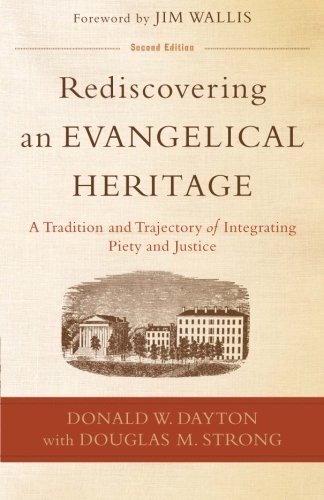Reviewed by Andrew J. Spencer
Rediscovering an Evangelical Heritage is the second edition of a 1976 book, published by Donald Dayton. The book in its original form was drawn from a series of essays for the periodical Post American, which is now Sojourners. The first edition, originally titled Discovering an Evangelical Heritage, was published by Harper & Row, but was reprinted with the addition of a preface in 1988 by Hendrickson. The literary history of this volume raises questions about what is so significant about the material in this text that it should exist in four distinct forms.
The answer lies in the resurgence of the debate over the nature of Evangelicalism. George Marsden and Donald Dayton were active interlocutors about the question, with Marsden arguing for a doctrinal definition and Dayton championing a sociological definition of Evangelicalism. This book is written to provide a history of Evangelicalism that is sociological rather than doctrinal.
The convoluted history of the volume helps explain the extensive front matter of the volume. Unique to the second edition, Jim Wallis writes a foreword and Douglas Strong contributes an introduction. Then Dayton’s preface for the 1988 reprint and his original 1976 prologue are included. The first chapter of the book does not begin until page 53 with a book that comes in at just over 200 pages. Strong’s contribution to this second edition is limited to an introductory essay, a few paragraphs added to several chapters, and an epilogue.
Overview
Most of the essays in Rediscovering an Evangelical Heritage relate to Charles Finney or those closely tied to him. The exception is the article on Jonathan Blanchard in the first chapter. Blanchard founded Wheaton College, which is still a major center of Evangelical learning. The interest for Dayton, however, is on Blanchard’s activism for abolition. Finney is the subject of the next chapter. He is lauded as a hero due to his rejection of tradition and insistence on interpreting Scripture independently. Finney is also rightly praised for his rabid abolitionism, an attitude transmitted to Oberlin College as well as others with whom he had contact.
Chapters Four and Five recount Finney’s founding of Oberlin College and the participation of Oberlin in the Underground Railroad respectively. According to Dayton, Oberlin College was supplemented with staff and students from Lane Theological Seminary who left that school because of their adamant abolitionist stance. This helps to explain the strong participation of citizens of Oberlin, many of whom were connected with the college, in freeing slaves and resisting the laws requiring escaped slaves to be returned to their owners. The sixth chapter relates the work of Arthur and Lewis Tappan, ardent supporters of Finney, in using their wealth and influence to aid slavery.
Dayton then shifts his focus from Finney directly to Wesleyans, who were also ardent supporters of abolition. Though it does not focus directly on people strongly linked to Finney, this chapter is staged using accounts from the Oberlin community newspaper. This it is little surprise when the Chapter Eight discusses the roots of feminism in Finney’s brand of Evangelicalism, though the Wesleyan Methodists are given credit for encouraging female preachers. The ninth chapter recounts some cases of evangelicals, notably doctrinally progressive ones, that felt especially called to serve the poor. Dayton finds role models in the Salvation Army and similar organizations, who were initially effective in reaching the poor with a form of Christianity. Dayton neglects to note the radical drift that most of the organizations he praises have taken from orthodox Christianity since their founding.
The final chapter makes explicit some of Dayton’s doctrinal biases against Calvinists (whom the authors identify with a cold orthodoxy) and other Evangelicals who find their identity in doctrine rather than the name of their denomination. In his epilogue to the second edition, Douglas Strong makes clear that, according to this volume, Evangelical identity in the nineteenth century is tied to orthopraxy rather than orthodoxy. For Dayton and Strong, the old paths of Evangelicalism are found in the names of denominations that exemplified the right sort of social attitudes, rather than in faithfulness to articles of faith derived from Scripture.
Evaluation
Rediscovering an Evangelical Heritage has been republished at a time when another major effort is being made to redefine Evangelicalism as merely a social movement with negotiable understandings of significant, historical doctrines. The essays were written at a popular level, with no interaction with contrary positions, which gives a false impression that this notion is and has been uncontested. The volume is worth reading, but it is one-sided.
The chief strength of this volume is that it celebrates worthy social causes and shows how faithful men and women worked to end injustices in the name of Christ. It represents the history of the revivalistic segment of American Christianity in the 19th century well and tells stories that are useful in motivating Christians for social activism. The historical anecdotes are well chosen to inspire well-intended social activism.
The book falls short of being ideal by presenting a particular interpretation of the nature of evangelicalism without referencing other options. The essays also fail to note the significant doctrinal decay that has resulted for most of denominations and institutions tied to the case studies in this volume. For example, Oberlin College, founded by Finney and highlighted several times in the book, is no longer distinctly Christian. Similarly, the Salvation Army is now much less concerned with a biblical notion of salvation than its name indicates. If the result of Strong’s approach to evangelicalism is a loss of the gospel, then the price is not worth the benefit. In the end, despite the authors’ conclusions to the contrary, robust orthopraxis is possible alongside clearly expressed orthodoxy. This is the ideal which we should pursue.
Andrew J. Spencer is a PhD student at Southeastern Baptist Theological Seminary, Wake Forest, NC.
